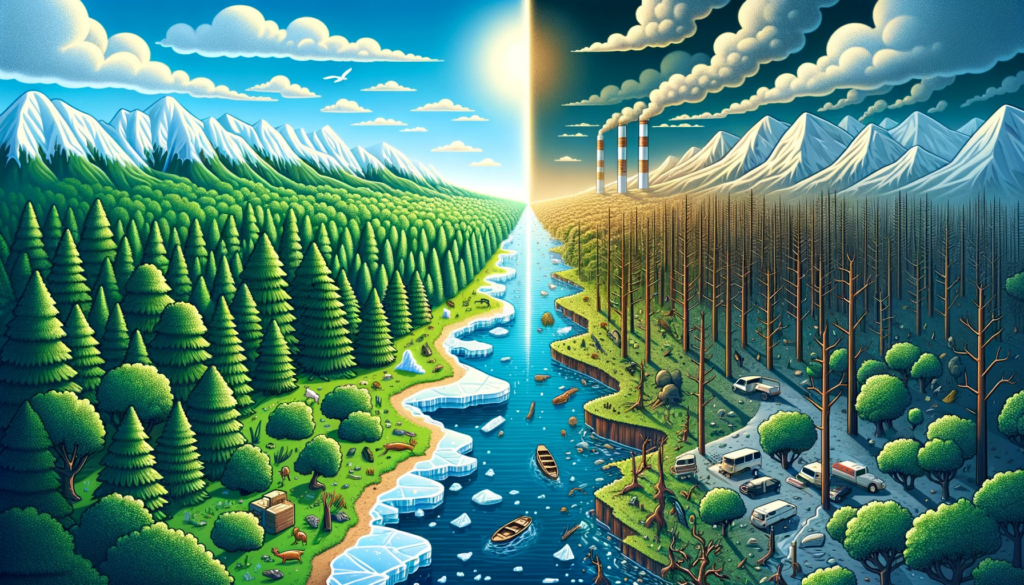Understanding Climate Change

Climate change is a big problem that the world faces today. It means that the weather on Earth is getting warmer at a fast rate. The main cause of this warming is human activity, such as using cars and factories. These actions release gases that trap heat in the atmosphere. This effect is known as the greenhouse effect. Over time, it leads to an increase in the planet’s overall temperature.
One of the biggest issues of climate change is that ice at the poles is melting. This causes sea levels to rise and can lead to flooding in coastal areas. Animals that live in these cold places are also losing their homes. This is why some animals, like polar bears, are in trouble.
Another issue is that the weather patterns are changing around the world. Some places get a lot more rain and floods happen, while other places get very dry. Farmers find it hard to grow food when the weather changes a lot. This can lead to food shortages and higher prices in shops.
People around the world are working to fix these problems. One way to help is to use less electricity and water. People can also ride bikes or walk instead of driving cars. Governments are making laws to control how much pollution factories can make. They are also trying to make more power from the sun and wind, which is cleaner.
The most important thing is that everyone understands how serious climate change is. If we all work together, we can protect the Earth for future generations. It starts with small changes in how we live every day. We must take care of our planet, as it is the only home we have.
General Level: B1.1
Vocabulary: A2.1
Verb Form: A1.6
Clause: B1.0
Wordlist
coastal ADJ B2 1
Definition (En):
- of or relating to a coast
a. located on or near or bordering on a coast
flooding NOUN B2 1
Definition (En):
n a technique used in behavior therapy; client is flooded with experiences of a particular kind until becoming either averse to them or numbed to them
v fill quickly beyond capacity; as with a liquid
v cover with liquid, usually water
v supply with an excess of
v become filled to overflowing
greenhouse NOUN B2 1
Definition (En):
- a building with glass walls and roof; for the cultivation and exhibition of plants under controlled conditions
a. of or relating to or caused by the greenhouse effect
melt VERB B2 1
Definition (En):
- reduce or cause to be reduced from a solid to a liquid state, usually by heating
v. lose its distinct outline or shape; blend gradually
v. become less intense and fade away gradually
overall ADJ B2 1
Definition (En):
- (usually plural) work clothing consisting of denim trousers (usually with a bib and shoulder straps)
n. a loose protective coverall or smock worn over ordinary clothing for dirty work
s. involving only main features
s. including everything
polar ADJ C2 1
Definition (En):
- having a pair of equal and opposite charges
a. located at or near or coming from the earth’s poles
a. of or existing at or near a geographical pole or within the Arctic or Antarctic Circles
pole NOUN C1 1
Definition (En):
- a long (usually round) rod of wood or metal or plastic
n. a native or inhabitant of Poland
n. one of two divergent or mutually exclusive opinions
n. one of two points of intersection of the Earth’s axis and the celestial sphere
shortage NOUN B2 1
Definition (En):
n the property of being an amount by which something is less than expected or required
n an acute insufficiency
trap VERB B2 1
Definition (En):
- a device in which something (usually an animal) can be caught and penned
n. drain consisting of a U-shaped section of drainpipe that holds liquid and so prevents a return flow of sewer gas
n. something (often something deceptively attractive) that catches you unawares
n. a device to hurl clay pigeons into the air for trapshooters
warming NOUN B2 1
Definition (En):
- imparting heat
Phrases and Idioms
Lemma | Sentences |
lead to (something) | · Over time, it leads to an increase in the planet’s overall temperature. · This causes sea levels to rise and can lead to flooding in coastal areas. · This can lead to food shortages and higher prices in shops. |
as it is | · We must take care of our planet, as it is the only home we have. |
greenhouse effect | · This effect is known as the greenhouse effect. |
how much | · Governments are making laws to control how much pollution factories can make. |
in trouble | · This is why some animals, like polar bears, are in trouble. |
instead of (something) | · People can also ride bikes or walk instead of driving cars. |
live in something | · Animals that live in these cold places are also losing their homes. |
on earth | · It means that the weather on Earth is getting warmer at a fast rate. |
other place | · Some places get a lot more rain and floods happen, while other places get very dry. |
over time | · Over time, it leads to an increase in the planet’s overall temperature. |
small change | · It starts with small changes in how we live every day. |
start with (someone or something) | · It starts with small changes in how we live every day. |
such as | · The main cause of this warming is human activity, such as using cars and factories. |
take care of (someone or something) | · We must take care of our planet, as it is the only home we have. |
trap (someone or something) in (something) | · These actions release gases that trap heat in the atmosphere. |
work together | · If we all work together, we can protect the Earth for future generations. |
True / False / Not Given
- The world is dealing with the issue of climate change.
- The weather on Earth is cooling down quickly because of climate change.
- Cars and factories do not affect the greenhouse effect.
- The ice at the poles never melts.
- Polar bears are having a hard time because their homes are disappearing.
- The weather patterns around the world are staying the same.
- Food prices are falling because of stable weather conditions.
- Using less electricity and water can help with climate change problems.
- Governments are banning all factories to stop pollution.
- Small changes in our daily lives can help protect the Earth for future people.
It's Your Turn!
Create your multiple choice questions for this reading lesson just in seconds!
Step 1: Click the button to copy the reading text
Step 2: Go to Exercise Creator
Step 3: Paste the reading text
Select question type (Multiple Choice)
Click “Create” and your questions will be ready in seconds!
Short Answer Questions
- Why is the weather on Earth getting warmer?
- What is the greenhouse effect?
- What happens when ice at the poles melts?
- Why are polar bears in trouble?
- What can happen to farmers due to changing weather patterns?
- What do floods and dry weather lead to?
- What are people around the world doing to deal with climate change?
- How can using less electricity and water help the planet?
- How are governments trying to reduce pollution from factories?
- What must we do to protect the Earth for future generations?
True / False / Not Given Answers
1.
Answer: True
Explanation: The text starts by mentioning that climate change is a significant problem that the world is facing, which makes the statement true.
Answer location: “Climate change is a big problem that the world faces today.”
2.
Answer: False
Explanation: The text explicitly states that Earth’s weather is getting warmer, not cooler, which is the opposite of the statement.
Answer location: “It means that the weather on Earth is getting warmer at a fast rate.”
3.
Answer: False
Explanation: The text clearly states that human activities like using cars and factories contribute to the greenhouse effect.
Answer location: “The main cause of this warming is human activity, such as using cars and factories.”
4.
Answer: False
Explanation: The text directly mentions that ice at the poles is melting as one of the big issues of climate change.
Answer location: “One of the biggest issues of climate change is that ice at the poles is melting.”
5.
Answer: True
Explanation: The text indicates that animals, including polar bears, are in trouble because they are losing their homes due to climate change.
Answer location: “Animals that live in these cold places are also losing their homes. This is why some animals, like polar bears, are in trouble.”
6.
Answer: False
Explanation: The text clearly states that weather patterns are changing, which contradicts the statement.
Answer location: “Another issue is that the weather patterns are changing around the world.”
7.
Answer: False
Explanation: The text says that unstable weather leads to food shortages and higher prices, not lower prices.
Answer location: “This can lead to food shortages and higher prices in shops.”
8.
Answer: True
Explanation: The text suggests that using less electricity and water is one method to help with climate change issues.
Answer location: “One way to help is to use less electricity and water.”
9.
Answer: Not given
Explanation: The text mentions governments making laws to control pollution from factories but does not say that they are banning all factories.
Answer location: “N/A”
10.
Answer: True
Explanation: The text concludes by stating that small daily changes can contribute to protecting the Earth for future generations, making the statement true.
Answer location: “It starts with small changes in how we live every day. We must take care of our planet, as it is the only home we have.”
It's Your Turn!
Create your multiple choice questions for this reading lesson just in seconds!
Step 1: Click the button to copy the reading text
Step 2: Go to Exercise Creator
Step 3: Paste the reading text
Select question type (Multiple Choice)
Click “Create” and your questions will be ready in seconds!
Short Answer Answers
1.
Answer: Human activity.
Explanation: The text states that human activities like using cars and factories are the main cause of the Earth getting warmer.
Answer location: “The main cause of this warming is human activity, such as using cars and factories.”
2.
Answer: Gases that trap heat in the atmosphere.
Explanation: The greenhouse effect is described as gases trapping heat in the atmosphere.
Answer location: “These actions release gases that trap heat in the atmosphere. This effect is known as the greenhouse effect.”
3.
Answer: Sea levels rise.
Explanation: As ice melts at the poles, the text explains that this results in rising sea levels.
Answer location: “This causes sea levels to rise and can lead to flooding in coastal areas.”
4.
Answer: Losing their homes.
Explanation: Polar bears are in trouble because they are losing their homes due to the melting ice.
Answer location: “Animals that live in these cold places are also losing their homes.”
5.
Answer: Hard to grow food.
Explanation: The text mentions that changing weather patterns make it difficult for farmers to grow food.
Answer location: “Farmers find it hard to grow food when the weather changes a lot.”
6.
Answer: Food shortages and higher prices.
Explanation: The consequence of floods and dry spells as described in the text includes food shortages and increased prices.
Answer location: “This can lead to food shortages and higher prices in shops.”
7.
Answer: Working to fix these problems.
Explanation: The text states that globally, people are making efforts to address climate change issues.
Answer location: “People around the world are working to fix these problems.”
8.
Answer: Helps to fix problems.
Explanation: Using less electricity and water is presented as one of the ways to help fix problems caused by climate change.
Answer location: “One way to help is to use less electricity and water.”
9.
Answer: Making laws.
Explanation: To curb factory pollution, governments are enforcing laws according to the text.
Answer location: “Governments are making laws to control how much pollution factories can make.”
10.
Answer: Work together.
Explanation: The protection of Earth for the future requires collective effort, as mentioned in the text.
Answer location: “If we all work together, we can protect the Earth for future generations.”
Create Your Own Lesson with Cathoven AI
You can create your own reading lesson based on your interests or those of your students!
Go to;
Type the topic you are interested in, select the level and genre you are looking for, and click Generate!
Paste the reading text you generated and get a detailed analysis of your text.
Select the type of exercise, paste the reading text, and click Create!
Your reading lesson is ready!




